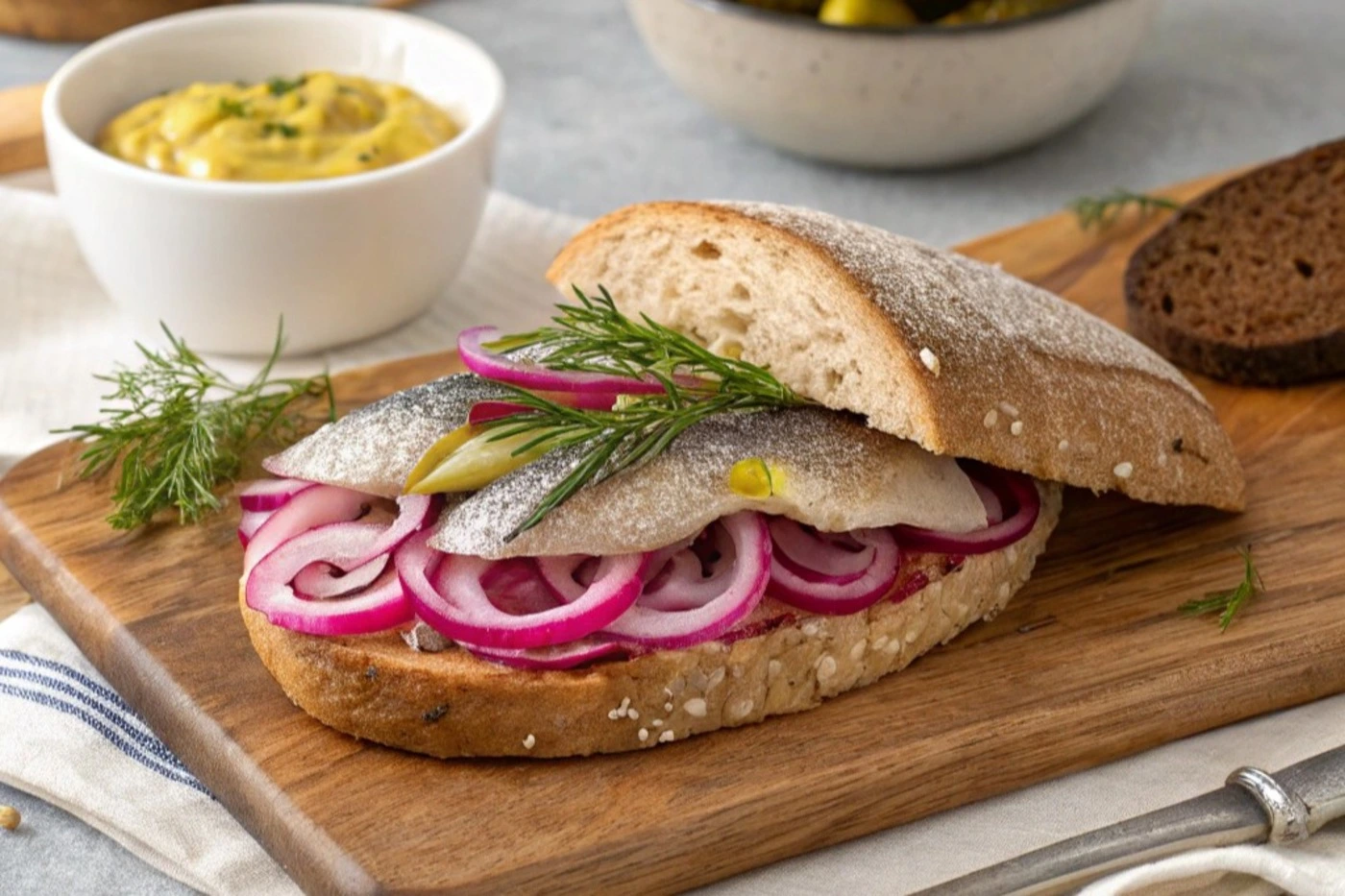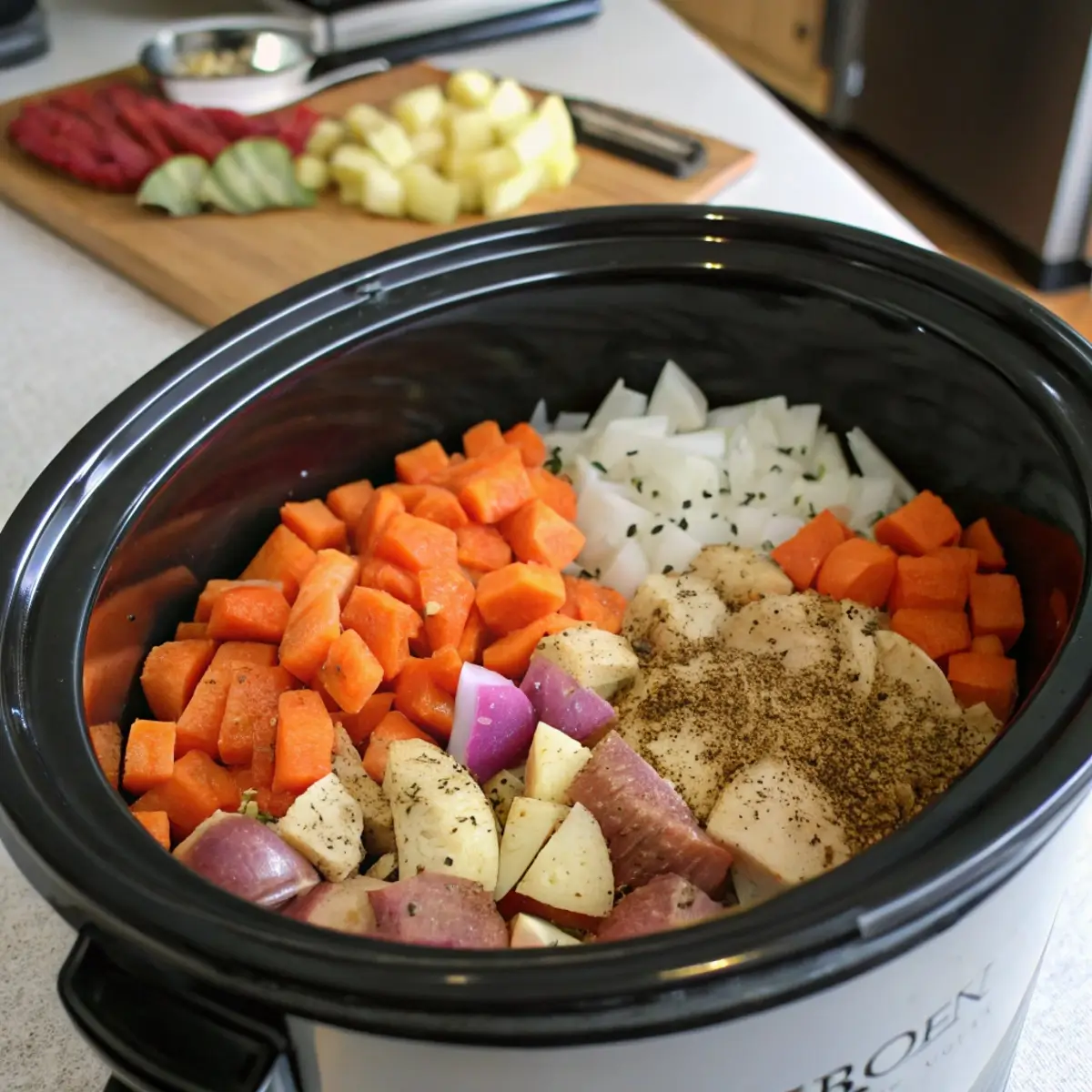Table of Contents
- 1 Introduction to Matjesbrötchen
- 2 What is Matjesbrötchen?
- 3 The History and Tradition of Matjesbrötchen recipe
- 4 How to Make a Traditional Matjesbrötchen Recipe
- 5 Popular Variations of Matjesbrötchen Recipe
- 6 Creative Matjesbrötchen Recipes
- 7 Pairing Suggestions for Matjesbrötchen Recipe
- 8 Health Benefits of Matjesbrötchen
- 9 FAQs About Matjesbrötchen Recipe
- 10 Why You Should Try Matjesbrötchen Recipe
Introduction to Matjesbrötchen
When it comes to iconic German sandwiches, matjesbrötchen stands tall as a beloved, flavorful dish, often enjoyed during festivals and everyday meals alike. If you’re unfamiliar with the term, don’t worry — we’re about to introduce you to this tasty treat and its rich history. Matjesbrötchen recipe is more than just a herring sandwich; it’s an experience packed with fresh ingredients, cultural significance, and a delicious blend of flavors that will surely win over any food lover.
In this article, we’ll take a deep dive into the world of matjesbrötchen, exploring its origins, the best ways to prepare it, and even some fun variations to try. So, whether you’re a herring enthusiast or someone looking to broaden your culinary horizons, this matjesbrötchen recipe will guide you every step of the way.
What is Matjesbrötchen?
Matjesbrötchen is a popular German sandwich made primarily with matjes herring, a mild, pickled version of the fish. It’s typically served in a soft bread roll, complemented by onions, cucumbers, and other fresh toppings. This dish is a staple in Germany, particularly in coastal regions where herring is abundant. The matjes herring is the star of the show, with its delicate flavor and tender texture, perfectly paired with the other ingredients.
But what exactly makes matjesbrötchen so special? It’s the combination of the fish, fresh bread, and tangy, crunchy veggies that creates an unforgettable balance of flavors. The sandwich can be enjoyed as a light meal or snack, offering a taste of Germany’s maritime heritage in every bite.
Why Matjesbrötchen is a Beloved German Dish
Matjesbrötchen holds a special place in the hearts of Germans, particularly in the northern regions where fresh herring is widely available. It’s not just the taste that makes this dish so beloved; it’s also tied to German culture and tradition. In fact, matjes season (typically around the late spring and early summer) is eagerly awaited, and matjesbrötchen becomes the dish of choice to celebrate the arrival of the fresh herring.
The simplicity of this sandwich belies its cultural importance. Whether eaten as part of a festive gathering or on a casual day, the fresh flavors of matjesbrötchen evoke a sense of nostalgia for many who grew up enjoying it. This humble yet satisfying sandwich has become a true representation of German comfort food.
Key Ingredients for Matjesbrötchen recipe
The secret to a delicious matjesbrötchen lies in its fresh ingredients. Here’s a quick rundown of the essential components that make up this classic sandwich:
- Matjes Herring: The heart and soul of the dish, this pickled fish offers a mild yet rich flavor.
- Bread Rolls: Typically, a soft white or rye roll serves as the base for the sandwich, providing a satisfying texture.
- Onions: Raw onions add a crunchy, sharp contrast to the richness of the fish.
- Cucumbers: Thinly sliced cucumbers add a refreshing crunch, balancing the overall flavor.
- Butter or Margarine: A light spread on the bread adds creaminess and helps bind the flavors together.
These ingredients combine to create the perfect matjesbrötchen, but don’t be afraid to experiment with a few extras to make it your own. For instance, adding fresh herbs or pickled vegetables can elevate the dish even further. The options are endless!
The History and Tradition of Matjesbrötchen recipe
The History of Matjes Herring
Matjes herring, often the key ingredient in matjesbrötchen, has a rich history that spans centuries. This special preparation of herring comes from the Dutch term “matjes,” meaning “young herring.” The fish is caught when it’s still young, just before it begins to mature, and is preserved using a pickling process that gives it a tender, delicate flavor. Traditionally, matjes herring was seen as a way to preserve the fish for the long winter months when fresh fish wasn’t available.
In Germany, matjes herring was quickly embraced as a culinary treasure. Historically, the fish was salted and cured to ensure it could last through the colder months, and its versatility in cooking soon gained popularity. Over time, the process of curing the fish was refined, leading to the milder, slightly sweet version that’s enjoyed in matjesbrötchen today. This simple, yet flavorful dish became a staple across Germany, especially in coastal regions where herring fishing was a primary industry.
The matjes itself became a celebrated item, not only for its long shelf life but also for its nutritional benefits. Rich in omega-3 fatty acids and protein, it provided a healthy source of food for generations. The tradition of eating matjes herring during certain seasons, like the arrival of fresh herring in late spring, continues to be an important part of German food culture today.
Matjesbrötchen’s Role in German Culinary Culture
As time went on, matjes herring became a centerpiece in various German dishes, but perhaps most notably in the matjesbrötchen. This herring sandwich emerged as a convenient and flavorful way to enjoy the cured fish. The popularity of matjesbrötchen skyrocketed, especially as a street food and snack. Vendors would sell these sandwiches, often as a quick lunch or on-the-go meal, drawing in both locals and tourists.
The significance of matjesbrötchen is deeply rooted in German culinary culture. It’s not just a delicious meal; it’s also a symbol of German maritime heritage. The dish is associated with German holidays and festivals, where it is often served as part of a larger feast. During matjes season (known as “Matjeszeit”), you’ll find the sandwich featured at local markets, festivals, and even in specialty food shops. Its presence during such celebrations has made matjesbrötchen a nostalgic dish for many, representing a time-honored tradition that continues to delight the taste buds of Germans young and old.
How to Make a Traditional Matjesbrötchen Recipe
Essential Ingredients for Matjesbrötchen Recipe
To make a traditional matjesbrötchen, you need to gather a few essential ingredients. The quality and freshness of these ingredients will directly impact the taste of your sandwich, so be sure to choose them carefully.
- Matjes Herring: The star of the dish, matjes herring is the key ingredient. Choose high-quality, fresh herring that’s been pickled and is tender to the touch. It should be mild in flavor with a slight sweetness.
- Fresh Bread Rolls: Ideally, choose soft bread rolls. Rye bread is the classic option, but white rolls also work well, providing a light texture that complements the herring. The bread should be fresh and slightly crispy on the outside.
- Onion: Raw onions are commonly used in matjesbrötchen for their sharpness and crunchy texture. Thinly sliced onions add the perfect bite to balance the fish’s flavor.
- Cucumbers (or other vegetables): Sliced cucumbers are a traditional topping, adding a refreshing crunch. You can also use other pickled or fresh vegetables like radishes or beets for extra flavor.
- Butter or Margarine: A light spread of butter or margarine on the bread adds a creamy texture and ensures the sandwich isn’t too dry.
- Fresh Herbs (like dill or parsley): Fresh herbs like dill or parsley can be used to garnish the sandwich and enhance the overall flavor.
Step-by-Step Recipe for Matjesbrötchen
Making a traditional matjesbrötchen is simple, but there are a few key steps to follow for the perfect sandwich:
- Prepare the bread: Start by slicing your fresh bread rolls in half. If you’re using rye bread, consider lightly toasting the halves to give them a little extra crunch. Spread a thin layer of butter or margarine on both halves of the bread.
- Prepare the herring: Drain the matjes herring from its brine and pat it dry with a paper towel. Depending on your preference, you can leave the herring whole or slice it into smaller pieces.
- Assemble the sandwich: Place the matjes herring on one side of the bread. Add a few thin slices of onion and cucumber for crunch. If you’re using fresh herbs, sprinkle them on top for an extra burst of flavor.
- Finish with seasoning: Add a pinch of salt and pepper to taste. Some people even like to drizzle a little bit of mustard or a creamy sauce to give the sandwich an extra twist.
- Serve: Place the top half of the bread onto the sandwich, press gently, and your matjesbrötchen is ready to enjoy!
Customizing Your Matjesbrötchen Recipe
While the traditional matjesbrötchen is fantastic as it is, you can easily customize it to suit your taste. Here are a few ideas:
- Different bread types: Instead of the usual rye or white bread, try using a whole-grain roll or a baguette for a different texture.
- Extra toppings: Get creative with additional toppings like avocado, radishes, or even a boiled egg for added protein.
- Sides: Pair your sandwich with a side of potato salad, fresh greens, or even a tangy pickle to complete the meal.
Popular Variations of Matjesbrötchen Recipe
While the traditional matjesbrötchen is beloved for its simplicity, there are plenty of ways to personalize this classic dish to suit different tastes and preferences. Let’s explore some popular variations and creative twists.
Matjesbrötchen with Pickled Vegetables
One popular variation is adding pickled vegetables to your matjesbrötchen. The tangy flavor of pickled cucumbers, onions, or even beets works beautifully with the sweetness of the herring. These vegetables add extra crunch and a burst of flavor that contrasts with the soft texture of the bread. Pickled red onions, in particular, add an extra depth of flavor and color, making the sandwich more vibrant and exciting.
Matjesbrötchen with Boiled Egg
Another tasty option is to add a boiled egg to your matjesbrötchen. The creamy yolk enhances the richness of the sandwich, complementing the salty and tender herring. A sliced boiled egg brings additional protein and a creamy texture that blends perfectly with the crispness of the bread and the acidity of the vegetables.
Matjesbrötchen with Mustard or Cream Sauce
For a slightly more indulgent twist, some people enjoy matjesbrötchen with a drizzle of mustard or a cream sauce. Mustard adds a tangy kick that pairs well with the salty herring, while a creamy sauce (think sour cream or a simple mayonnaise-based sauce) brings richness and balance to the sandwich. This variation is perfect for those who want a more complex, full-bodied flavor.
Creative Matjesbrötchen Recipes
While the traditional matjesbrötchen is already wonderful, modern chefs are experimenting with different ingredients to give it a fresh, innovative spin. Some creative variations include:
- Avocado: Add a layer of creamy avocado for a smooth and mild contrast to the sharpness of the herring. The avocado adds richness and helps to mellow out the flavors.
- Radishes: Thinly sliced radishes offer a peppery crunch that pairs well with the tender fish. Their bright color and crisp texture are a refreshing complement to the soft herring and bread.
- Seasonal Vegetables: You can also experiment with other seasonal vegetables like arugula, spring onions, or even roasted peppers for extra flavor and texture. These add vibrant colors and fresh, peppery notes to the dish.
Pairing Suggestions for Matjesbrötchen Recipe
What to Serve with Matjesbrötchen
When it comes to enjoying matjesbrötchen, the right sides can really elevate the dish. While the sandwich itself is rich in flavor, pairing it with complementary side dishes can enhance the overall meal.
Sides That Complement Matjesbrötchen
- Potato Salad: A classic pairing with matjesbrötchen is potato salad. The creamy, tangy dressing of a traditional German potato salad balances out the sharpness of the herring. You can go for a classic recipe with mustard, pickles, and boiled eggs, or opt for a lighter version made with a vinaigrette.
- Pickled Vegetables: Since matjes herring has a tangy and briny flavor, adding pickled vegetables like cucumbers, beets, or onions can make for a wonderful contrast. These crunchy, vinegary sides work perfectly to cut through the richness of the sandwich.
- Fresh Salads: A crisp green salad with fresh herbs and a light vinaigrette offers a refreshing balance to the richness of the sandwich. Arugula, spinach, or mixed greens work well, especially with a hint of lemon dressing.
Drinks That Go Well with Matjesbrötchen
The right drink can make your matjesbrötchen experience even more enjoyable. Here are a few non-alcoholic options that pair beautifully with this dish:
- Sparkling Water: A glass of sparkling water with a twist of lemon is a light and refreshing choice that helps cleanse the palate between bites. It also adds a nice effervescence that complements the savory flavor of the herring.
- Herbal Tea: A mild herbal tea, like chamomile or mint, pairs wonderfully with matjesbrötchen. The subtle herbal flavors can enhance the freshness of the bread and toppings without overpowering the delicate taste of the herring.
- Fruit Juices: For a slightly sweet contrast, fruit juices like apple or cranberry can be a good match. Their tangy sweetness helps balance the saltiness of the herring.
Health Benefits of Matjesbrötchen
Nutritional Value of Matjes Herring
Matjes herring is not only a flavorful addition to your diet but also a nutritious one. Rich in omega-3 fatty acids, matjes provides essential nutrients that are great for heart health, reducing inflammation, and supporting brain function. These healthy fats also help keep your skin glowing and contribute to overall wellness.
Moreover, matjes herring is an excellent source of protein and vitamins, including vitamin D and vitamin B12, which are important for maintaining energy levels, strong bones, and a healthy immune system. The fresh ingredients in your matjesbrötchen, such as onions and cucumbers, add even more health benefits. Onions are high in antioxidants, while cucumbers offer hydration and a low-calorie crunch.
How to Make Matjesbrötchen Healthier
If you want to make a lighter version of your matjesbrötchen, there are a few easy tweaks you can make. First, opt for whole-grain bread instead of white rolls. Whole grains are higher in fiber and provide more nutritional value, helping you stay fuller longer.
You can also reduce the amount of butter or margarine used in the sandwich. Try spreading a thin layer or even using a light yogurt-based spread instead. By making these small changes, you can enjoy a healthier version of this delicious dish without compromising on taste.
Looking for more traditional German recipes? Check out this guide to classic German sandwiches and dishes.
FAQs About Matjesbrötchen Recipe
What is the difference between Matjes and other types of herring?
Matjes herring is distinct from other types of herring due to its unique preparation process. Unlike regular salted herring, matjes is caught when the fish is still young and has a higher fat content, making it tender and mild in flavor. The fish is preserved using a gentle pickling method, which gives it a distinct sweetness and less pungency compared to other preserved herring varieties like rollmops or pickled herring.
Can I make a vegetarian version of Matjesbrötchen Recipe?
Yes! While the traditional matjesbrötchen features herring as the main ingredient, you can easily make a vegetarian version using marinated vegetables or tofu. For instance, pickled cucumbers, onions, and beets can replace the herring, while smoked tofu can add a similar texture and savory depth. This vegetarian variation keeps the essential flavors of the original dish intact while catering to plant-based diets.
How do I store leftover matjes herring?
If you have leftover matjes herring, it should be stored in the refrigerator in an airtight container. The herring will stay fresh for up to 2-3 days. Be sure to keep it in its original brine to preserve its texture and flavor. Leftover sandwiches can also be wrapped and stored in the fridge, but they are best enjoyed fresh.
Can I freeze Matjesbrötchen?
While it’s generally not recommended to freeze matjesbrötchen once assembled, the matjes herring itself can be frozen. However, freezing may alter its texture, so it’s best to enjoy the dish fresh. If you have leftover matjes herring, simply store it in its brine and freeze it for up to 2 months. When you’re ready to use it, allow it to thaw in the refrigerator overnight before making your sandwich.
Why You Should Try Matjesbrötchen Recipe
Matjesbrötchen is more than just a sandwich—it’s a delicious reflection of German culinary tradition. This iconic dish brings together the rich, tender flavors of matjes herring, the freshness of crisp vegetables, and the satisfying texture of soft bread. Whether you enjoy it as a quick snack, a street food delight, or as part of a festive meal, matjesbrötchen offers something for everyone.
Beyond its irresistible taste, matjesbrötchen carries cultural significance, representing an age-old tradition that has been passed down through generations. It’s a dish that evokes memories of summer festivals, family gatherings, and leisurely moments by the sea. Plus, its versatility allows for creative adaptations, making it suitable for various diets and personal tastes.
If you haven’t yet tried this classic German treat, it’s time to dive in and experience the vibrant flavors and history of matjesbrötchen. With its simple ingredients and exceptional taste, it’s a dish that will quickly become a favorite.





